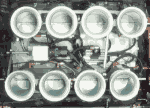|
CommieGIR posted:Thats the joke. Oh. I did a GIS and the links sent me to some poo poo about the new ones so I assumed that was the new one. I didn't actually read them though.
|
|
|
|

|
| # ? May 4, 2024 22:09 |
|
This sounded pretty interesting even though it eliminates what really makes a manual transmission so fun to drive. http://blog.caranddriver.com/clutch-player-this-tech-just-may-be-the-future-of-automotive-transmissions/ It looks like automated float shifting a non-synchronous transmission with two electric motors providing rev matching, uninterrupted torque to the wheels, and taking over the function of (and eliminating) first and reverse gear. Sounds less complicated than a dual-clutch transmission and less frustrating than an automated manual transmission. Though this all seems simple enough, I wonder why this hasn't been done before? Edward IV fucked around with this message at 04:07 on Jul 6, 2016 |
|
|
|
Edward IV posted:This sounded pretty interesting even though it eliminates what really makes a manual transmission so fun to drive. The unnamed manufacturer is probably VAG, whose engineers showed up breathless and sweating to their offices, eager to shove something even more exotic and unreliable than the PDK into a Porsche.
|
|
|
|
Edward IV posted:This sounded pretty interesting even though it eliminates what really makes a manual transmission so fun to drive. Because it's solving a problem that mostly doesn't exist? Cars like the Honda Accord Hybrid and GM's hybrid systems are basically this, except without the "shifting gears" part because the electric motors have enough power that the engine can just be connected directly to the wheels at a fixed gear ratio, and the electric motors just sort out the torque/power/RPM issues amongst themselves. I guess with this system you could make the electric motors and battery relatively smaller, so that they only need to deal with 1st and 2nd gear, and have the gearbox operate normally for the other gears, but that's got to be a vanishingly small niche.
|
|
|
|
8ender posted:The unnamed manufacturer is probably VAG, whose engineers showed up breathless and sweating to their offices, eager to shove something even more exotic and unreliable than the PDK into a Porsche. Is PDK really unreliable? I've never heard anything like that, and I thought ZF was the supplier of PDK along with the dual clutch BMW and Audi uses anyway. The primary advantage of PDK seems to be that you can basically build the same box but without the dual clutches and it would just be a manual, saving you some development, and it might be marginally lighter and easier to package than a conventional auto, in a 911 anyway. Certainly dual clutch VAG cars are not any faster or more fuel efficient than GM or Toyota competitors that use regular autos.
|
|
|
|
Is a weak point in that powertrain the output of the transmission into the driveline electric motor? Like if you did a hard standing start, the motor's shaft would need to handle the torque difference? Or would you have really fuckin weak starts off the line since the ICE can't help right away? Unless you specced a heavier and counter-design-goal motor?
|
|
|
|
According to the article the driveline motor is supposed to be sized to put out just enough peak power to break the tyres loose at a standstill. This ought to be more than enough to handle even very hard starts, since you'll be limited by traction. It doesn't have to put out full power very long, so it can be comparatively small for a relatively high peak power - you'd only need peak power for a few seconds at a time at most, only during initial takeoff and shifting. A lower continuous power output would cover operation in stop-start 10kph traffic. Essentially this system becomes a series hybrid at very low speeds (with a generator on the engine and a motor on the driveshaft) with the wheels completely decoupled from the engine. Once you're doing probably 25kph or so (or whenever you'd usually shift into 2nd) is when it starts actually applying ICE power to the wheels. It's very cool technically, and it looks like something that has potential, and I suspect one of the first production applications we might see will be the aston-martin am-rb 001 as towards the end of that article Newey goes on to talk about how doubleclutches are heavy and big and they're working on something "special" literally a fish fucked around with this message at 07:21 on Jul 7, 2016 |
|
|
|
literally a fish posted:According to the article the driveline motor is supposed to be sized to put out just enough peak power to break the tyres loose at a standstill. I dunno how power electrics work, but isn't peak power still a function of motor size? To brake the tires loose would require a motor roughly inbetween a Leaf's and what's in a Tesla (I'm assuming one of the 2 used would be enough). That eats quite a bit into your clutch savings. I'm still not saying it's a bad design because of that, just that the weight argument maybe doesn't hold water.
|
|
|
|
Do you need power to break the tires loose? I thought it was just torque. You would need power to take the car to 200mph, and that's when the engine kicks in.
|
|
|
|
Power = torque at a given RPM. A BLDC motor will put out the same continuous power until it runs out of rpm, pretty much. kimbo305 posted:I dunno how power electrics work, but isn't peak power still a function of motor size? To brake the tires loose would require a motor roughly inbetween a Leaf's and what's in a Tesla (I'm assuming one of the 2 used would be enough). That eats quite a bit into your clutch savings. I'm still not saying it's a bad design because of that, just that the weight argument maybe doesn't hold water. For the most part, peak power is a function of motor cooling system (liquid or air) and MOSFET size. You can run relatively small liquid cooled BLDC motors well above continuous power limits for brief periods. Continuous power (and cooling system) along with voltage to some degree will dictate size.
|
|
|
|
That's a lot of work to reduce the very small amount of loss you get from slipping your clutch during starts and shifts. Lots of added weight, too. All that copper to run that big motor is going to outweigh the savings from not having synchros etc., not to mention having a battery big enough to move your car and start the engine at the same time.
|
|
|
|
EightBit posted:That's a lot of work to reduce the very small amount of loss you get from slipping your clutch during starts and shifts. Lots of added weight, too. All that copper to run that big motor is going to outweigh the savings from not having synchros etc., not to mention having a battery big enough to move your car and start the engine at the same time. You could have a car with a massive V12 gas engine or something, and turn it into a sort of mild hybrid, and this setup I guess would allow it to do low speeds on electric only, and also have fast, cheap gearbox without adding too much weight overall. And you don't need to license anything from Toyota/Aisin. It's got to be a pretty small niche.
|
|
|
|
Throatwarbler posted:Because it's solving a problem that mostly doesn't exist? Cars like the Honda Accord Hybrid and GM's hybrid systems are basically this, except without the "shifting gears" part because the electric motors have enough power that the engine can just be connected directly to the wheels at a fixed gear ratio, and the electric motors just sort out the torque/power/RPM issues amongst themselves. I guess with this system you could make the electric motors and battery relatively smaller, so that they only need to deal with 1st and 2nd gear, and have the gearbox operate normally for the other gears, but that's got to be a vanishingly small niche. At least in the case of the Honda Accord Hybrid, it only uses the direct connection with a fixed ratio at highway speeds, where that gear ratio matches the engine's most efficient powerful RPM range to the expected driving speed range. Otherwise it's disconnected from the drivetrain and only drives the generator. http://www.autonews.com/article/20130930/OEM06/309309954/how-the-honda-accords-innovative-hybrid-system-works
|
|
|
|
EightBit posted:That's a lot of work to reduce the very small amount of loss you get from slipping your clutch during starts and shifts. Lots of added weight, too. All that copper to run that big motor is going to outweigh the savings from not having synchros etc., not to mention having a battery big enough to move your car and start the engine at the same time. I'm assuming that all the wiring and motors/electronics are already present (i.e. the vehicle was going to be a hybrid anyway) since this seems most likely to land up in high-end hybrid super/hypercars than anything else right now; the weight reduction in the transmission isn't really a goal, it's packaging (this is significantly smaller than a doubleclutch) and improving the performance characteristics of the overall system while being able to use significantly smaller batteries/electric motors than you need in a series hybrid (like the Accord Hybrid outside of highway cruising mode) On the other hand, I'm not seeing any real benefit over the prius-type electro-CVT option, which has even less moving parts and significantly simpler control software E: it's really just the accord hybrid system with a 5-speed gearbox and some really fancy software for clutchless shifting/torque fill that will inevitably poo poo the bed and lunch your drivetrain literally a fish fucked around with this message at 04:10 on Jul 8, 2016 |
|
|
|
Some part of me just wants someone to release a "just suck it up and drive it" edition supercar. "No, gently caress your torque fill and hybrids and idling and stuff, just drive the loving thing". I mean it won't happen, but I want it.
|
|
|
|
mekilljoydammit posted:Some part of me just wants someone to release a "just suck it up and drive it" edition supercar. "No, gently caress your torque fill and hybrids and idling and stuff, just drive the loving thing". They already happened. F40, Diablo, F1, etc. "Here you go. CF tub, MR layout, too much power for the tire technology we're working with, and things may get a bit burny. Try not to kill yourself."
|
|
|
|
Boaz MacPhereson posted:They already happened. F40, Diablo, F1, etc. Right, exactly what I had in mind, more like that.
|
|
|
|
Boaz MacPhereson posted:They already happened. F40, Diablo, F1, etc. Yes please
|
|
|
|
Boaz MacPhereson posted:They already happened. F40, Diablo, F1, etc. Please, sir, I want some more?
|
|
|
|
Phy posted:Please, sir, I want some more? NO! HYBRIDS FOR EVERYONE! AND AWD! AND MORE ELECTRICAL DOODADS THAN THE SPACE SHUTTLE!
|
|
|
|
So basically grab a current McLaren tub scrape out the fancy poo poo, replace with an angry supercharged new LT1.
|
|
|
|
Boaz MacPhereson posted:NO! HYBRIDS FOR EVERYONE! AND AWD! AND MORE ELECTRICAL DOODADS THAN THE SPACE SHUTTLE! I need a sensor for my sensor.
|
|
|
|
Wrar posted:So basically grab a current McLaren tub scrape out the fancy poo poo, replace with an angry supercharged new LT1. I'm not sure that's angry enough. If I were king of the world, http://www.engdev.com/engines/judd-gv-4-2-litre-v10/ or http://www.engdev.com/engines/judd-gv-5-0-and-5-5-l-v10/ would do. Or really, alternately, the McLaren engine isn't bad, being a semi-civilized version of a purpose build race engine. Just keep the P1s big turbos and ignore the torque fill bullshit.
|
|
|
|
literally a fish posted:On the other hand, I'm not seeing any real benefit over the prius-type electro-CVT option, which has even less moving parts and significantly simpler control software Pretty much all the other hybrid systems on the market are basically a cheat to get around Toyota's patents/IP on the HSD system. The technical aspects of it are mostly secondary, although both GM and Honda's systems actually do turn out to be at least as good if not better. Look at VW/Audi's hybrid efforts for an example of when it all goes wrong.
|
|
|
|
mekilljoydammit posted:I'm not sure that's angry enough. If I were king of the world, http://www.engdev.com/engines/judd-gv-4-2-litre-v10/ or http://www.engdev.com/engines/judd-gv-5-0-and-5-5-l-v10/ would do. Either one of those or one of these: http://falconerengines.com/falconer_v12.php
|
|
|
|
Boaz MacPhereson posted:Either one of those or one of these: http://falconerengines.com/falconer_v12.php Falconer V12 is always also acceptable.
|
|
|
|
mekilljoydammit posted:Some part of me just wants someone to release a "just suck it up and drive it" edition supercar. "No, gently caress your torque fill and hybrids and idling and stuff, just drive the loving thing".
|
|
|
|
Is there a good resource for learning about shimming dampers? I'm in the middle of revalving my Yamaha R6 forks and have been inside of my YZ450F forks and rear shock. Some of the stuff I've only been able to find tiny hints of truth about or assumed based on little underlying info is starting to click, mostly because I happened across http://45537.activeboard.com/ which seems to have be filled by couple of -huge- names a few years ago that hinted about how certain stacks worked and how certain manufacturers (Ohlins, Ktech, Penske, TraxxionDynamics, GP Suspension, etc) approached things differently for similar results. From what I can tell a reshimmed stock Showa cart will take you anywhere you want to go... despite what the internet has prior lead me to believe. Obviously no handholding happens here, very black art, but still. 
BlackMK4 fucked around with this message at 02:49 on Jul 19, 2016 |
|
|
|
Anyone have any books or links on designing and building a dry sump system? May be looking at one for the new project. Found this which is a pretty good overview - http://www.musclecardiy.com/performance/how-to-build-racing-engines-sumps-and-oiling/ NitroSpazzz fucked around with this message at 16:23 on Jul 22, 2016 |
|
|
|
Thing that occasionally occurs to me when looking at pre-V8-era cars: would it be possible (aside from the obvious ridiculous price tag) to make one of those old engines (say, the Duesenberg J I8, of the Hudson Hornet I6; actually the latter mase as much power as similarly-sized SBC V8s did in the '70s, so maybe bad example) with modern materials and internals so as to get modern power numbers? The Duesenberg had a supercharged DOHC 7-liter/420CI eight, but it ran 5.7:1 compression and so only a couple hundred horsepower. Any technical reason that design couldn't make 1000hp if built today, even if it was only made of better materials with compression ratio for modern gas? As an extension, I then began to wonder the same of the WWII aero engines, but I guess that HAS been done -- the Reno racers are squeezing 3500+hp out of Merlins, which is over twice the stock power rating, and a fairly respectable (even by modern car engine standards) 130hp/litre. Except I feel there's a certain diminishing-returns thing there that makes it really amazing; 130hp/L in, say, motorcycle engines seems to be fairly common these days, but you don't see many 800+hp Chevy 350s (I'm sure they do exist, briefly; see NASCAR engines, but 150+hp 1L I4s are common). I guess it's because the little bike engines have lower rotating mass, and can thus rev to the drat moon without making GBS threads rods out the sides, and big V8s tend to come apart at around 7k rip'ems, 9k at the insane exotic race engines end, because when the piston hits TDC or BDC, the inertia is such that modern materials science can only just come up with a conrod that can handle the forces? To get near-literbike power/displacement rations out of a 27-litre V12 seems ... horribly dirty, somehow. Like the engine builders traded their souls and some really freaky sexual favors to [insert your preferred deity/devil] to get the laws of physics temporarily suspended.
|
|
|
|
I think you'd need to treat it as a clean-sheet design. Truly old engine designs like those often had much worse oiling / bearing setups than anything remotely modern, and I think with an inline-8 you start running into problems keeping the crank stable because it's just so loving long. Also, what era of the '70s are you talking about for "similar sized V8"? A quick glance at Wikipedia seems to claim 210hp SAE gross from the most hopped up factory version, which maybe put it on par with a mid-trim Ford 289 or Chevy 327. The SBC seems ancient now, but compared to nearly everything before it, it was incredibly modern.
|
|
|
|
Delivery McGee posted:Thing that occasionally occurs to me when looking at pre-V8-era cars: would it be possible (aside from the obvious ridiculous price tag) to make one of those old engines (say, the Duesenberg J I8, of the Hudson Hornet I6; actually the latter mase as much power as similarly-sized SBC V8s did in the '70s, so maybe bad example) with modern materials and internals so as to get modern power numbers? I think the old engines had very archaic head and valve designs that could not possibly flow as much air as modern engines, so you could give it a modern DOHC head but then what would it have in common with the old engine after that? The problem with very long inline engines is that the crankshaft starts to flex at high revs. Even I6s have this problem. An I6 could make sense for either a very big diesel like the Cummins or a luxury car that doesn't rev too high, with a lot of forced induction to make the power at low revs, but it's still probably no better than a V6 or V8 except for packaging in FR cars.
|
|
|
|
I was at the IMSA Weather Tech race at Lime Rock and noticed that the Ford GT and Corvette racing teams had pitot tubes on the nose of their cars. I know they're for airspeed, but what specifically would a race car need that for that instead of just using wheel speed?
|
|
|
|
Aero? You can probably get a lot of information sampling airspeed at various points on the chassis.
|
|
|
|
It was just the one in the front as far as I could see. It is positioned well above the boundary layer and in front of any possible turbulence as well, so it's definitely used for air speed. The corvette has two in the same location. Assuming one is redundant. Edit: Maybe something for drafting? um excuse me fucked around with this message at 04:11 on Jul 28, 2016 |
|
|
|
um excuse me posted:I was at the IMSA Weather Tech race at Lime Rock and noticed that the Ford GT and Corvette racing teams had pitot tubes on the nose of their cars. I know they're for airspeed, but what specifically would a race car need that for that instead of just using wheel speed? I believe Lotus used them for their reactive suspension system in the 80s. Specifically it drove the ride height of the cars to optimize aero and the pitot is more effective at that than wheel speed. Don't know if that's the exact use here but I'd imagine its something similar.
|
|
|
|
Not bothering quoting because lazy HP/L is misleading when boost goes into the picture. Merlin power outputs climbing during WW2 were basically a factor of better fuel and superchargers and the rest of the engine being made to take it, and Reno versions are pretty much extensions of that theme, with the addition of the fact that you can use water spray for cooling stuff for a short period of time that you couldn't otherwise. The head and combustion chamber design flies (ha, puns) in the face of what we've learned since then, but it's not like there'd be a market for making new ones. Like was said, it's not so much a matter of materials holding older engines back as it was a matter of design having not been figured out yet or because the design was driven by materials. The Duesenberg engine seems like it had a lot of modern style features, but I'm willing to bet that if you started upping the compression you'd run into it burning valve seats. Also, willing to bet that you can't make it rev simply because they optimized it for what was possible back then - there weren't valve springs that could control big valves and that would last, and the followers wouldn't be hardened as well, so the cams were designed gentle and the ports smaller than would be needed to make huge power, and so on. In theory, you could port it, move the valve centerlines, mill the bucket bores for larger followers so you could use more aggressive cams, put better rods and pistons and bearings in, modern valve seats and so on and so forth, but by that point it's not much of a Duesenberg engine anymore. A good example of an engine that happened to be done right such that it could cope with higher outputs was the Offy I4s though, which showed up in top level racing between 1933 and 1982. It wasn't precisely the same engine all those years, but it's a good example of something where the basic architecture allowed updating. As for pitot tubes on race cars, there's no such thing as active/reactive/etc suspension anymore - not allowed anywhere, pretty much. But air speed does tell you some potentially useful things. Looking at the data system you can do things like figure out prevailing wind speed and direction and make adjustments - for example if there's a consistent headwind on a long straight maybe you want to trim out some wing.
|
|
|
|
Said Offy was making insane power by the end, too, courtesy of massive turbochargers.
|
|
|
|
In 1935 Alfa 8C had a supercharged 2.9 litre all-aluminium DOHC straight eight that make 220 hp @ 5300 rpm (295 hp in racing trim). I think it was the fastest production car at the time. It had fully independent suspension, coil springs and hydraulic dampers as well.
|
|
|
|

|
| # ? May 4, 2024 22:09 |
|
Interesting list of intentional failures/breaks that people have apparently tried to pull: https://www.quora.com/How-did-you-foil-dodge-someone-elses-attempt-to-cheat-or-deceive-you/answer/Eric-Bradley-6
|
|
|






























 Bad Angus! Bad!
Bad Angus! Bad!




